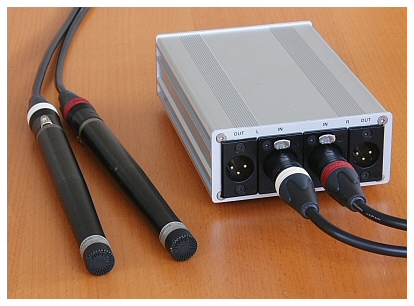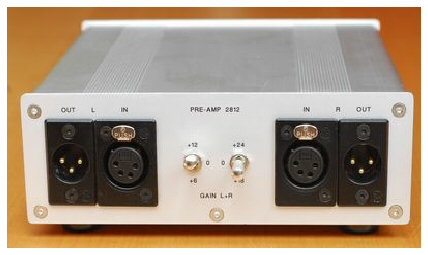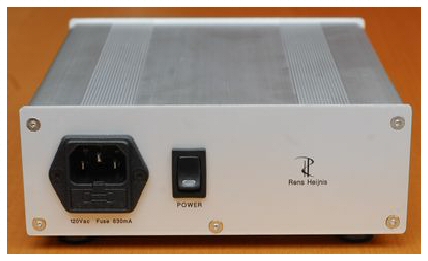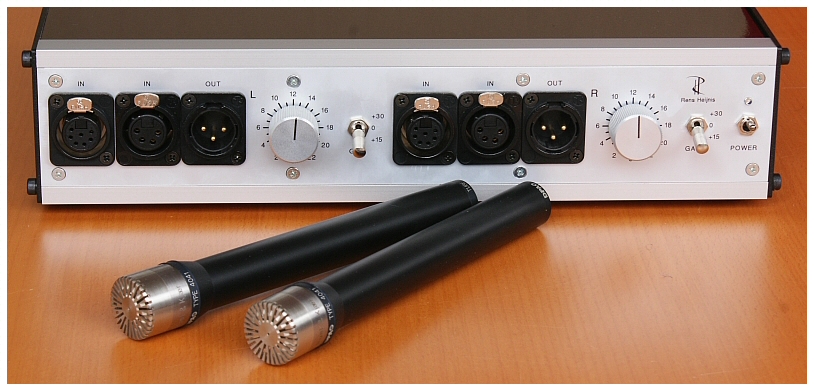 Rens Heijnis custom-built audio equipment
Rens Heijnis custom-built audio equipment
Improve the sound of your B&K /DPA microphone by retrofitting and separated power supply.
When you are not satisfied with the sound of your microphone: too sharp, strident, thin, lacking vibrancy
or anything else, it is possible to retrofit your microphone with better electronics to improve the sound.
Retrofitting is possible for nearly all B&K/DPA condenser microphones such as 4003 4004 4006 4006A
4011 4011A 4041.
After retrofitting your microphone has a smoother sound, less sharp and strident, more vibrancy.
At the former microphones page you can read the theory about retrofitting:
DPA also use the inferior sounding SMD printed circuit boards in his modern microphones.
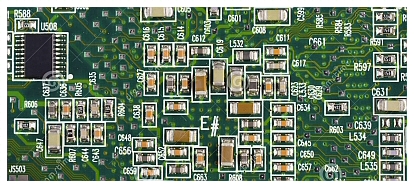
A retrofitted microphone has a new printed circuit board with trough-hole components.
All the components are selected for there proven sound quality.
Mains power supply for active powered B&K /DPA microphones
No phantom power is used so an external power supply is necessary.
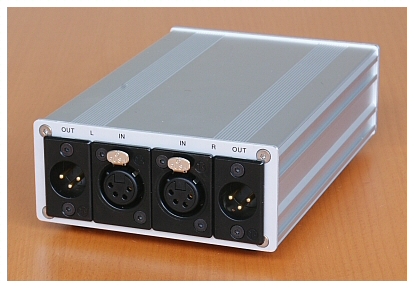
Technical Specifications PS-402
Number of channels: 2
Input: 4-pin XLR female connector
Output: 3-pin XLR male connector
Power requirements: 105-120V and 210-240V, 50 to 60 Hz
Power consumption max: 3W
Weight: 1 kg
Dimensions: 108mm Χ 165mm Χ 52mm (4.3 x 6.5 x 2.1)
The microphone Cable for active powered microphones
A special microphone cable is necessary between the microphone and power supply.
The standard microphone cable is a Mogami starquad cable: Mogami 2534
For the +60V norm it is supplied with 4 pin XLR connectors.
Every cable length is available.
The output of the power supply is a normal 3 pin XLR.
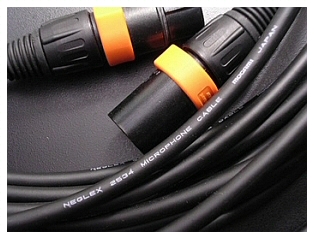
For microphone cables with an other sound than the Mogami see: Microphone Cables
B&K measurement capsule with a normal microphone house.
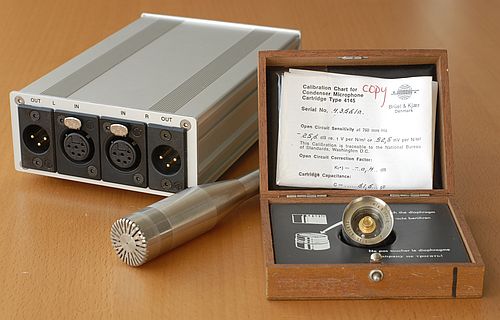
B&K 4145 1" measurement capsule with a normal microphone house and active power.
B&K 4134 1/2" capsule is also possible.
2 channel power supply with 60V and 200V capsule voltage.
Retrofitted DPA4041 with active power
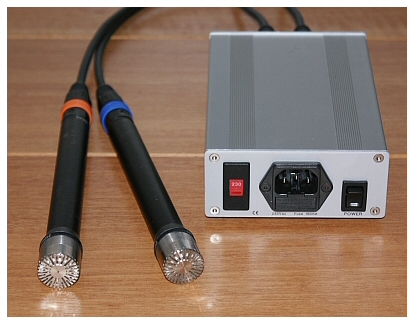
DPA4041 phantom, modified to active powered.
2 channel power supply with 60V and 200V capsule voltage (with 5pin XLR).
With Black Gate capacitor and other components selected for there sound quality.
Retrofitted DPA4041SP with battery powered power supply
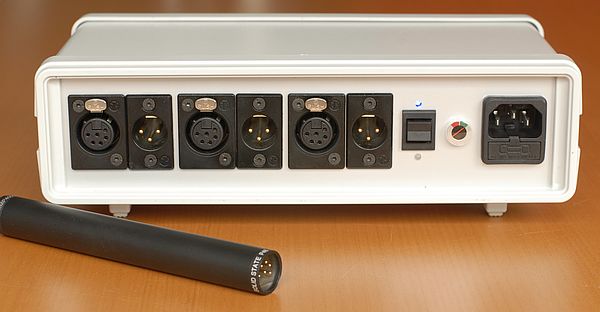
DPA4041SP phantom, retrofitted to active power with battery power.
With Black Gate capacitor and other components selected for there sound quality.
Technical Specifications power supply
Number of channels: 3
Input: 6-pin XLR female connector. (not the modified DPA 7 pin XLR)
Output: 3-pin XLR male connector
Maximum operating time fully charged Li-ION batteries: 70 Hours
Power requirements: 90-264V, 50/60Hz
Dimensions: 255mm Χ 135mm Χ 70mm (10 x 5.3 x 2.7)
Retrofitted B&K4006 with active power
B&K4006 (20years old) phantom modified to active powered.
Reference from the customer:
They are now flatter throughout the upper register, less strident, without the annoying dip
in the 10-12k range they had before. The bottom
octave is slightly extended and improved.
Off axis response is noticeably better, and they seem faster - more 'bounce' in the meters.
Imaging is also more accurate now
Pre-amplifier and power supply for B&K /DPA 120V microphones,
Pre-amplifier for B&K/DPA 120V microphones, mains powered.
With the latest developments in improved sound quality
Dimensions: 28,5cm Χ 21,5cm Χ 7cm (11.2 x 8.5 x 2.7)
Gain: 0 to 53 dB (0 dB, 15 dB, 30 dB +0 to 23dB in 1dB steps)
Pre-amplifier and power supply for B&K /DPA 120V microphones, replacement for B&K 2812
Pre-amplifier for B&K/DPA 120V microphones.
Technical Specifications
Number of channels: 2
Gain: 0, 6, 12, 18 or 24dB
Input: 4-pin modified XLR female connector.
Maximum recommended cables length microphone-power supply: 10m unbalanced.
Output: 3-pin XLR male connector
Power supply pin 3: 120V
Power requirements: 210-240V, 50Hz
Weight: 1,5 kg
Dimensions: 170mm Χ 60mm Χ 170mm (6.7 x 2.4 x 6.7)
Power Supply for B&K /DPA 120V microphones

For connecting B&K/DPA 130V microphones on an external pre-amplifier.
Technical Specifications "DPA hi-voltage"
Number of channels: 2
Input: 4-pin modified XLR female connector.
Maximum recommended cables length microphone-power supply: 10m unbalanced.
Output: 3-pin XLR male connector
Maximum recommended cables length power supply-preamplifier: 30m balanced.
Power supply: 120V
Power requirements: 105-120V and 210-240V, 50 to 60 Hz
Power consumption max: 3W
Weight: 1 kg
Dimensions: 108mm Χ 165mm Χ 52mm (4.3 x 6.5 x 2.1)
Battery powered pre-amplifier for active powered B&K /DPA microphones
Sonodore MPB-502
Pre-amplifier for standard B&K /DPA Microdot and active powered B&K /DPA microphones
Special light weight (2,9kg) 3 channel pre-amplifier with Lithium ion batteries and the latest developments in improved
sound quality. With DPA MircoDot (4060serie) and active (6pin) microphone input. With battery power for the microphones.
Recording time 34 hours with active microphones, 43 hours with only DPA MicroDot.
Back view
Pre-amplifier for standard (not retrofitted) B&K /DPA 4041tube and 120V models
2 Channel pre-amplifier for DPA, B&K4041Tube and all 120V models. For replacement of the HMA4000/5000.
With a special battery stabilized power supply. With the latest developments in improved sound quality.
Reference on the retrofitted B&K4006 microphone with
a phantom 48V PCB.
David Spearitt Australia:
Have recorded quite a variety
of concerts with these microphones now. They sound wonderful.
Particularly the bass,
so solid and weighty. Recording the 32 Beethoven
sonatas at present and they sound superb for the big Steinway.
Also
recorded a soprano recital this evening where they excelled as well.
Many thanks for your thoroughly expert work as usual.
Reference on the retrofitted B&K4006 microphone with
an active 60V PCB.
Joseph Scott
California:
The first thing I noticed is that the
phase is completely different, and that I might need to spend some
time learning how
to place my microphones all over again. I record a
lot of solo acoustic guitar, from a distance of almost one meter away
from the chair in a fairly live room.
With the original microphone PCB I have
come to settle on a rather unconventional closely spaced pair, with
the bodies
parallel to each other, at a distance of about 5.75 inches
(14.6cm) from each other as a compromise of tonal balance
and stereo
image. I have a feeling that the differences I am hearing in the
tonal and phase accuracy of the new PCBs
that I will be able separate
the microphones a bit more and settle for much less compromises!
Tonally, the microphones are quite
different. I hear a lot more detail in the low frequencies, and
clarity in the high
frequencies with the new PCB. The mid range
frequencies are where the biggest tonal benefit that I've noticed is;
before the mid-range sound seemed to always be a bit exaggerated and
fatiguing in comparison to everything
else - and now it's much
clearer and feels right.
I've also noticed that the image is
robust. Let me explain. With the original PCB, the image with few
notes played on the
guitar would usually be pretty stable. When
playing a complicated guitar part (solo fingerstyle acoustic) the
image would
become much less clear, to the point one would have to
sometimes struggle to hear where all the notes are coming from.
Now
I hear the image to be very stable and easy to "see" no
matter how many notes or sounds are coming from the guitar.
Also, the transient response feels much
better timed to the note which it supports. A pluck or hit of a
sting results in a much
better connected sound as picked up by the
microphone. I suppose many people would say the microphone is
"faster".
To me, it sounds like the microphone is simply
reproducing all frequencies within a very similar time delta (and
perhaps
before, the phase of the higher frequencies was slightly
different than that of the other frequencies - causing a smearing
disconnect). The result is a much clearer recording, much more open
and natural.
To be fair, the PCBs are not the only
thing that has changed in my system. With the new active power
scheme I was able
to remove the dc blocking transformer. In the past
I had experimented with DC blocking transformers and different
capacitors and settled on a custom transformer as the best
compromise. With the new PCB I am using a single
1.5uf Vcap TFTF .
I also notice quite a bit more output (maybe 4 to 6dB) from the new PCBs.
Steven Wielink Netherlands:
We are very satisfied with the modified version of the B&K4006.
It gives a fantastic open and very lifelike imagery.
The bass is very clean and goes very deep without being predominate.
Steven Cahen
I have used the L&R mics of the new
4006 as an AB, and they sound absolutely stunning.
I can't
believe the low end sharpness and response, totally awesome!
Price list retrofitting microphones


















